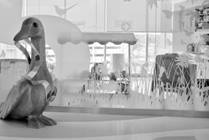Search Results
Viewing: 371-380 of 11723 | All

Condition
Hypothyroidism
This Helping Hand™ explains the cause, types, symptoms, diagnosis, and treatment for hypothyroidism.
Rubella
Rubella, also known as German measles, is an illness caused by a virus.
Craniosynostosis
Craniosynostosis is a medical condition where one or more of the openings (known as sutures) between skull bones have closed too soon. This will affect the shape of the skull. It can also mean that over time brain growth may be restricted. This could result in increased pressure on the brain.
Piriformis Syndrome
Piriformis (pee-ruh-for-muhs) syndrome is a rare condition in the back of the hip, causing pain and sometimes loss of feeling in the back of the thigh. Pain often goes down to the bottom of the foot.

Condition
Gastroparesis
Gastroparesis is a condition that causes food and liquid to stay in the stomach for a long time.

Condition
Ménière's Disease
Ménière's disease is a balance disorder caused by an abnormality found in a section of the inner ear called the labyrinth.
Increased Intracranial Pressure
Increased intracranial pressure (ICP) means greater than normal pressure on the brain. It results from a greater volume of fluid or swelling of the brain. Call 911 if your child loses consciousness or has convulsions (seizures) lasting longer than 5 minutes.

Condition
Limb Length Discrepancy (LLD)
A limb length discrepancy (LLD) is when one arm or leg is longer than the other arm or leg. Leg length discrepancies are very common. There are two main causes of leg length discrepancy: a condition that caused one leg to grow slower or something like an injury affected the growth of the bone.

Condition
Gonadal Dysgenesis
Gonadal dysgenesis, also known as 46XY gonadal dysgenesis and Swyer syndrome, is a condition in which the ovaries or testes (gonads) did not form the right way during pregnancy. Treatment may include surgery or hormone therapy.

